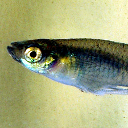Assembly
The ASM309773v1 assembly was submitted by University of Georgia on May 2018. The assembly is on scaffold level, consisting of 73,682 contigs assembled into 2,943 scaffolds. The N50 size is the length such that 50% of the assembled genome lies in blocks of the N50 size or longer. The N50 length for the contigs is 17,511 while the scaffold N50 is 6,651,460.
Gene annotation
The western mosquitofish (Gambusia affinis) is a species of freshwater fish, also known commonly, if ambiguously, as simply mosquitofish or by its generic name, Gambusia, or by the common name gambezi. There is also an eastern mosquitofish (G. holbrooki).Mosquitofish are small in comparison to many other freshwater fish, with females reaching an overall length of 7 cm (2.8 in) and males at a length of 4 cm (1.6 in). The female can be distinguished from the male by her larger size and a gravid spot at the posterior of her abdomen. The name "mosquitofish" was given because the diet of this fish sometimes consists of large numbers of mosquito larvae, relative to body size. Gambusia typically eat zooplankton, beetles, mayflies, caddisflies, mites, and other invertebrates; mosquito larvae make up only a small portion of their diet.Mosquitofish were introduced directly into ecosystems in many parts of the world as a biocontrol to lower mosquito populations which in turn negatively affected many other species in each distinct bioregion. Mosquitofish in Australia are classified as a noxious pest and may have exacerbated the mosquito problem in many areas by outcompeting native invertebrate predators of mosquito larvae. Several counties in California distribute mosquitofish at no charge to residents with manmade fish ponds and pools as part of their mosquito abatement programs. The fish are made available to residents only and are intended to be used solely on their own property, not introduced into natural habitat. On 24 February 2014, Chennai Corporation in India introduced western mosquitofish in 660 ponds to control the mosquito population in freshwater bodies.Fertilization is internal; the male secretes milt into the genital aperture of the female through his gonopodium. Within 16 to 28 days after mating, the female gives birth to about 60 young. The males reach sexual maturity within 43 to 62 days. The females, if born early in the reproductive season, reach sexual maturity within 21 to 28 days; females born later in the season reach sexual maturity in six to seven months.
The gene annotation process was carried out using a combination of protein-to-genome alignments, annotation mapping from a suitable reference species and RNA-seq alignments (where RNA-seq data with appropriate meta data were publicly available). For each candidate gene region, a selection process was applied to choose the most appropriate set of transcripts based on evolutionary distance, experimental evidence for the source data and quality of the alignments. Small ncRNAs were obtained using a combination of BLAST and Infernal/RNAfold. Pseudogenes were calculated by looking at genes with a large percentage of non-biological introns (introns of <10bp), where the gene was covered in repeats, or where the gene was single exon and evidence of a functional multi-exon paralog was found elsewhere in the genome. lincRNAs were generated via RNA-seq data where no evidence of protein homology or protein domains could be found in the transcript.
In accordance with the Fort Lauderdale Agreement, please check the publication status of the genome/assembly before publishing any genome-wide analyses using these data.
More information
General information about this species can be found in Wikipedia.
Statistics
Summary
| Assembly | ASM309773v1, INSDC Assembly GCA_003097735.1, May 2018 |
| Base Pairs | 598,663,367 |
| Golden Path Length | 598,663,367 |
| Annotation provider | Ensembl |
| Annotation method | Full genebuild |
| Genebuild started | May 2018 |
| Genebuild released | Jul 2018 |
| Genebuild last updated/patched | Jul 2018 |
| Database version | 115.1 |
Gene counts
| Coding genes | 21,724 |
| Non coding genes | 306 |
| Small non coding genes | 292 |
| Long non coding genes | 2 |
| Misc non coding genes | 12 |
| Pseudogenes | 27 |
| Gene transcripts | 33,089 |
Other
| Genscan gene predictions | 34,937 |
